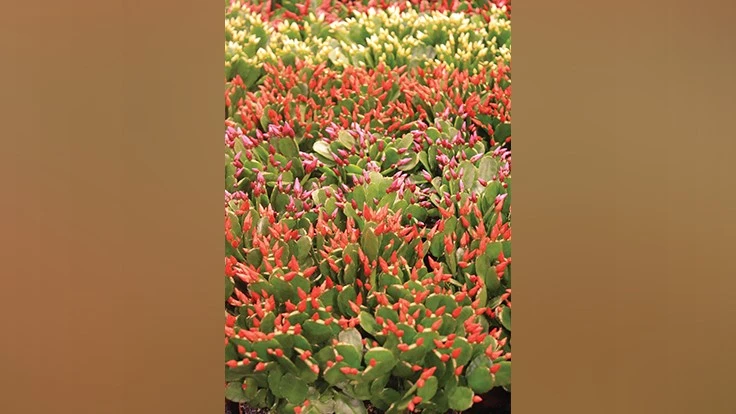

Holiday cactus refers to a group of succulent flowering potted plants, including Thanksgiving cactus (Schlumbergera truncata), Christmas cactus (a hybrid between Schlumbergera ×buckleyi) and Easter cactus (Hatiora gaertneri), which is closely related but in a different genus. The common names infer when these crops naturally flower and are marketed; Thanksgiving and Christmas cacti are traditionally fall and early winter flowering potted plants, whereas Easter cacti are traditionally a late-winter and spring potted plant. The flowering time is not the only way to tell these crops apart. The leaf margins of the Christmas cactus are scalloped with rounded lobes, while the pointed, upward facing lobes are characteristic of Thanksgiving cacti.
These crops can all be easily propagated from the individual phylloclades, or individual leaf-like stem segments. During propagation, be sure to provide long days from night-interruption or day-extension lighting from September to April to keep cuttings from flowering. While not particularly difficult to propagate, the crop time for transplants can be long. However, rooted liners can also be brought in to reduce the total crop time for this long-growing crop.
One rooted cutting is required per 4-inch container, while two to three cuttings per 6-inch container. The root zone pH should be maintained at the target for general crops (5.8 to 6.2), and 150 to 200 ppm nitrogen should be provided at each irrigation. For cooler temperatures during flower forcing, nitrate-based fertilizers should be used. While plants are bulking up in the summer, pull shade or use white wash to avoid high light (>700 µmol·m-2·s-1) and damaging foliage.
Holiday cacti initiate flowers in response to light and temperature cues, but specific requirements vary among the different species. Thanksgiving and Christmas cacti are classified as a short day plant and flower in response to short days when air temperatures are above ~62 to 65° F; however, at a 55° F air temperature, flowers can form under both long and short days and they become day-neutral with respect to their photoperiodic flowering response. Though it varies with forcing temperature and cultivar, crops require approximately eight weeks to flower from the start of short days.
Easter cactus flower forcing requires a few more steps. First, Easter cacti are similar to the other holiday cacti in that they require short days to induce flowering. Once plants are ready to be induced, grow plants at 60 to 70° F under short days. After three to four weeks of short day and warm temperatures, continue short days and drop the temperature to 47 to 55° F. After plants are vernalized or cooled for four to six weeks, air temperature can increase back to 60 to 70° F and long day conditions should be maintained to force flowers.
In order to produce high quality finished plants, plants should be leveled and treated with benzyladenine (BA) to maximize finished plant quality regardless of which holiday cacti are grown. Leveling and BA are used during bulking when plants are kept under vegetative conditions, as well as during forcing under conditions that promote flowering. During vegetative growth, foliar sprays of BA (100 ppm) should be applied seven days after plants are leveled. The BA application increases the number of branches forming from each removed phylloclade, and this will promote development of more phylloclades than would leveling alone.
Leveling and BA application should also occur under short days, but different approaches should be taken for black-cloth and natural-season crops. Thanksgiving and Christmas cacti and their hybrids should be leveled five to 10 days after the start of short days (black cloth or the estimated start of natural short days). For crops under natural day lengths, 50 to 200 ppm BA should be applied when buds are at the “pinpoint” stage and become just visible; it is important to wait until visible bud so plants are clearly induced, since applying too early may promote vegetative (i.e. phylloclade) growth. For crops under black cloth, BA (50 to 200 ppm) can be applied immediately after leveling or up to one day later.
Thanksgiving, Christmas and Easter cacti are crops that can add color to home from fall through spring. These guidelines are the fundamentals for producing these plants that add instant color to any interior and are easy for consumers to maintain.

Explore the August 2019 Issue
Check out more from this issue and find your next story to read.
Latest from Greenhouse Management
- Anthura acquires Bromelia assets from Corn. Bak in Netherlands
- Top 10 stories for National Poinsettia Day
- Langendoen Mechanical hosts open house to showcase new greenhouse build
- Conor Foy joins EHR's national sales team
- Pantone announces its 2026 Color of the Year
- Syngenta granted federal registration for Trefinti nematicide/fungicide in ornamental market
- A legacy of influence
- HILA 2025 video highlights: John Gaydos of Proven Winners





